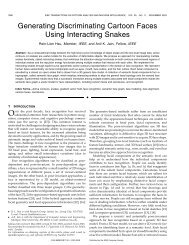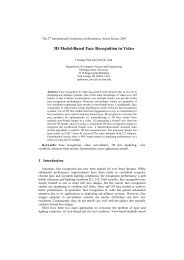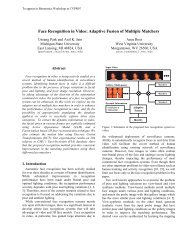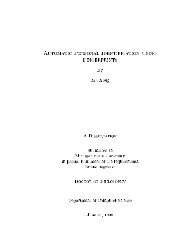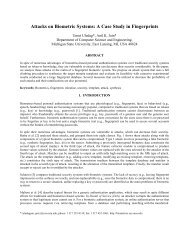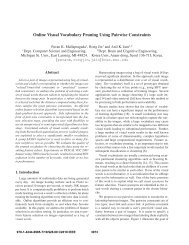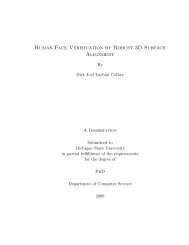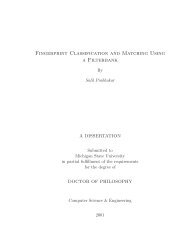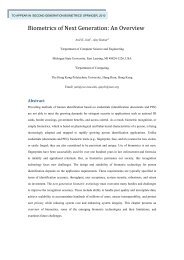Face Detection and Modeling for Recognition - Biometrics Research ...
Face Detection and Modeling for Recognition - Biometrics Research ...
Face Detection and Modeling for Recognition - Biometrics Research ...
Create successful ePaper yourself
Turn your PDF publications into a flip-book with our unique Google optimized e-Paper software.
2.3.3 3D Model Compression<br />
Among various representations of 3-D objects, surface models can explicitly represent<br />
shape in<strong>for</strong>mation <strong>and</strong> can effectively provide a visualization of these objects. The<br />
polygonal model using triangular meshes is the most prevalent type of surface representations<br />
<strong>for</strong> free-<strong>for</strong>m objects such as human faces. The reason is that the mesh<br />
model explicitly describes the connectivity of surfaces, enables mesh simplification,<br />
<strong>and</strong> is suitable <strong>for</strong> free-<strong>for</strong>m objects [136]. The polygonization of an object surface approximates<br />
the surface by a large number of triangles (facets), each of which contains<br />
primary in<strong>for</strong>mation about vertex positions as well as vertex associations (indices),<br />
<strong>and</strong> auxiliary in<strong>for</strong>mation regarding facet properties such as color, texture, specularity,<br />
reflectivity, orientation, <strong>and</strong> transparency. Since we use a triangular mesh to<br />
represent a generic face model <strong>and</strong> an adapted model, model compression is preferred<br />
when efficient transmission, visualization, <strong>and</strong> storage is required.<br />
In 1995, the concept of geometric compression was first introduced by Deering<br />
[137], who proposed a technique <strong>for</strong> lossy compression of 3-D geometric data.<br />
Deering’s technique focuses mainly on the compression of vertex positions <strong>and</strong> facet<br />
properties of 3-D triangle data. Taubin [75] proposed topological surgery which further<br />
contributed connectivity encoding (compression of association in<strong>for</strong>mation) to geometric<br />
compression. Lounsbery et al. [76] per<strong>for</strong>med geometric compression through<br />
multiresolution analysis <strong>for</strong> particular meshes with subdivision connectivity. Applying<br />
remeshing algorithms to arbitrary meshes, Eck et al. [138] extended Lounsbery’s<br />
work on mesh simplification. Typical compression ratios in this line of development<br />
52



